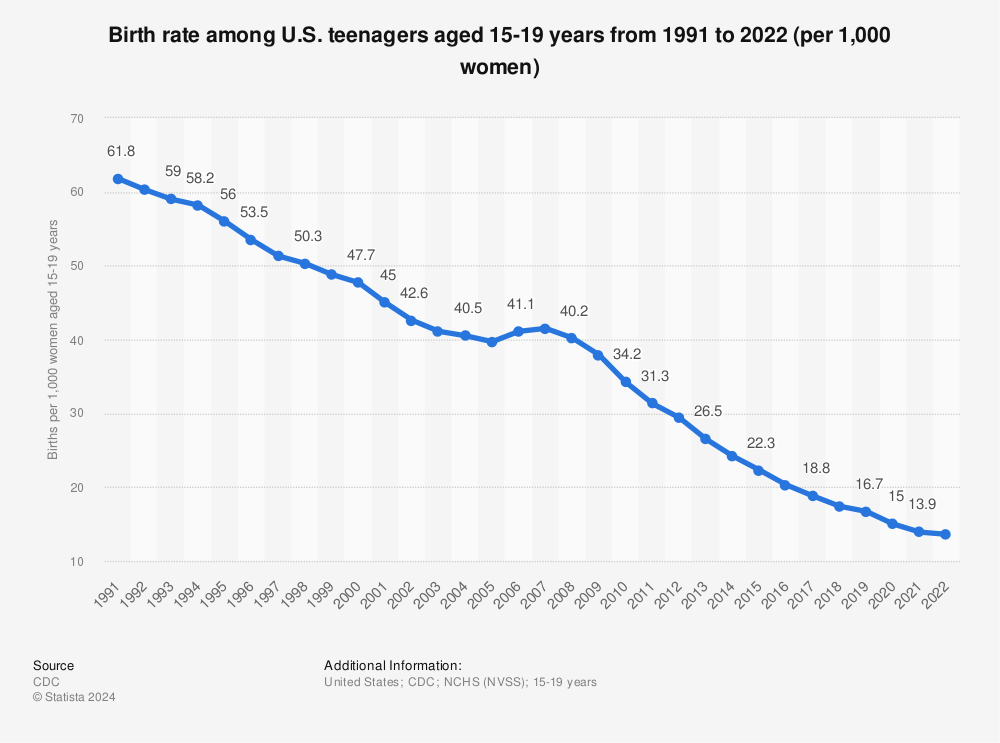
Statistics for Teen Pregnancy: Past, Present, and Future
Teen pregnancy has been a persistent issue in the United States for decades, with significant implications for both the young mothers and their children. Understanding the statistics surrounding teen pregnancy is crucial for developing effective prevention and support strategies. This article delves into the historical and current trends in teen pregnancy rates, exploring the factors that contribute to this issue and discussing potential solutions.
Historical Trends
In the mid-20th century, teen pregnancy rates in the United States were relatively high. In 1957, the birth rate for teenagers aged 15-19 was 96.3 per 1,000. However, rates began to decline in the 1960s and continued to fall steadily until the early 1990s. This decline was attributed to factors such as increased access to contraception, improved sex education, and changes in social norms.
Recent Trends
After reaching a low point in 1998, teen pregnancy rates began to rise again. By 2006, the birth rate for teenagers aged 15-19 had increased to 41.5 per 1,000. This increase was particularly pronounced among Hispanic and African American teenagers. Since 2006, rates have declined slightly but remain significantly higher than the historic low.
Current Statistics
According to the Centers for Disease Control and Prevention (CDC), the birth rate for teenagers aged 15-19 in the United States was 18.8 per 1,000 in 2020. This represents a decline of 5% from 2019. However, rates vary significantly by race and ethnicity. In 2020, the birth rate for Hispanic teenagers was 26.5 per 1,000, for African American teenagers it was 23.9 per 1,000, and for white teenagers it was 12.9 per 1,000.
Factors Contributing to Teen Pregnancy
Numerous factors contribute to teen pregnancy, including:
- Lack of access to contraception: Many teenagers do not have access to affordable or reliable contraception.
- Inadequate sex education: Some teenagers lack comprehensive and accurate information about sex and contraception.
- Peer pressure: Teenagers may feel pressured by their peers to engage in sexual activity.
- Poverty: Poverty can limit access to healthcare, education, and other resources that can help prevent teen pregnancy.
- Trauma: Teenagers who have experienced trauma or abuse are more likely to engage in risky sexual behaviors.
Consequences of Teen Pregnancy
Teen pregnancy has serious consequences for both the young mothers and their children. Young mothers are more likely to:
- Drop out of school
- Live in poverty
- Experience health problems
- Have children with low birth weight or premature birth
Children of teen mothers are more likely to:
- Have developmental delays
- Experience behavioral problems
- Drop out of school
- Become pregnant as teenagers themselves
Prevention and Support Strategies
Preventing teen pregnancy requires a multifaceted approach that includes:
- Comprehensive sex education: Providing teenagers with accurate and comprehensive information about sex, contraception, and healthy relationships.
- Increased access to contraception: Making contraception affordable and accessible to all teenagers.
- Peer support programs: Providing teenagers with a safe and supportive environment where they can discuss sexual health and make informed decisions.
- Economic empowerment: Addressing the underlying economic factors that contribute to teen pregnancy.
- Trauma-informed care: Providing support and services to teenagers who have experienced trauma or abuse.
Conclusion
Teen pregnancy remains a significant issue in the United States, with serious consequences for both young mothers and their children. Understanding the statistics surrounding teen pregnancy is essential for developing effective prevention and support strategies. By addressing the underlying factors that contribute to this issue and implementing evidence-based interventions, we can work towards reducing teen pregnancy rates and improving the lives of young people.